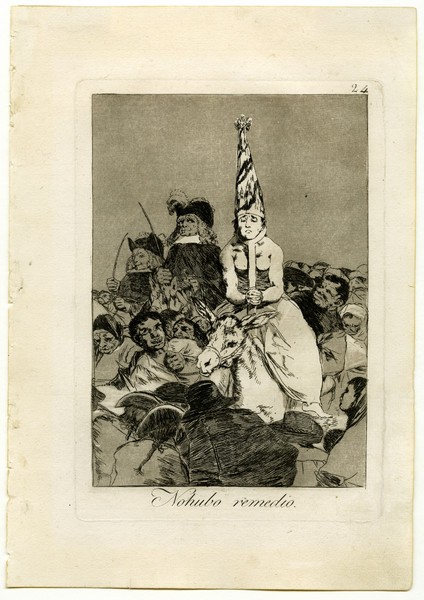- Cronología
- Ca. 1797 - 1799
- Dimensiones
- 219 x 152 mm
- Técnica y soporte
- Etching and burnished aquatint
- Reconocimiento de la autoría de Goya
- Undisputed work
- Ficha: realización/revisión
- 30 Nov 2010 / 29 May 2024
- Inventario
- 225
There was no remedy (at the bottom)
24. (in the upper right-hand corner)
See Francisco de Goya y Lucientes, Painter.
We do not know of the existance of a preparatory drawing for this engraving.
In this work, Goya continues with the theme of the Inquisition that he had tackled in No. 23, Those Powders. In the centre, slightly shifted to the right, the prisoner, who in this case appears to be a woman, is on the back of a donkey, with the chorus on his head and his torso bare. His head is held on his chin by a kind of crutch; the expression on his face is crestfallen and defeated. In front of the donkey, a grotesque-looking man pulls on the halter, while another man pushes the animal from behind. In the foreground, a group of men with pointed hats and pigtails lie on top of the prisoner; in the background, two feline-faced bailiffs on horseback with whips in their hands.
The Aragonese painter has used aquatint over the entire plate, although he has left some areas in white that coincide with the donkey and the prisoner on it. In addition to emphasising their prominence in the image, this could be a mechanism for suggesting the figure's innocence.
In Ayala's manuscript, it is stated laconically: "'She was armoured: she was poor and ugly. How could there be any remedy? A somewhat more extensive explanation is given in the manuscript in the Prado Museum, which reads as follows: "This Holy Lady is persecuted by death! After writing her life they bring her out in triumph. She deserves everything, and if they do it to affront her, it is time wasted. No one can be ashamed who has no shame".
As with the previous engraving, it is difficult to establish a clear link between the image and its title. Edith Helman believes that the latter refers to the failed attempts of Gaspar Melchor de Jovellanos (Gijón, 1744-Puerto de Vega, Navia, 1811) to reform the Inquisition when he was Minister of Grace and Justice, a post he took up in November 1797 and from which he was dismissed in August 1798. The Asturian writer and jurist was against this type of senseless inquisitorial process, based on ignorance and superstition. On 12 April 1799, in his Diary, he recalled the yearning with which he had hoped to carry out a series of reforms that did not come to fruition, concluding with the following words: "But there was no remedy". We can assume that Goya felt the same disappointment and was perhaps aware of Jovellanos's text, and we can even imagine that he used this phrase to title this print.
The plate is preserved in the National Chalcography (no. 195).
-
Goya. Gemälde Zeichnungen. Graphik. TapisserienKunsthalle BaselBasle1953from January 23th to April 12th 1953cat. 214
-
Five hundred years of fine printsLondresLondon1976exposición del 10 de febrero al 10 de marzo de 1976cat. 241
-
Goya. Das Zeitalter der Revolucionen. Kunst um 1800 (1980 – 1981)Hamburger KunsthalleHamburg1980cat. 30
-
Goya. La década de Los CaprichosMadrid1992organized by Real Academia de Bellas Artes de San Fernando sponsored by Fundación Central Hispano, Madrid, consultant editor Nigel Glendinnig. From October 26th 1992 to January 10th 1993cat. 96
-
Francisco de GoyaMuseo d'Arte ModernaLugano1996exhibition celebrated from September 22nd to November 17th.cat. 24, p. 51
-
Francisco Goya. Sein leben im spiegel der graphik. Fuendetodos 1746-1828 Bordeaux. 1746-1996Galerie KornfeldBern1996from November 21st 1996 to January 1997cat. 30
-
Goya artista de su tiempo y Goya artista únicoThe National Museum of Western ArtTokyo1999from December 1st to July 3th 1999cat. 130
-
Goya e la tradizione italianaFondazione Magnani RoccaMamiano di Traversetolo (Parma)2006consultant editors Fred Licht and Simona Tosini Pizzetti. From September 9th to December 3th 2006cat. 24, p.151
-
Goya. Opera graficaPinacoteca del Castello di San GiorgioLegnano2006exhibition celebrated from December 16th 2006 to April 1st 2007p.29
-
Goya et la modernitéPinacothèque de ParisParís2013from October 11st 2013 to March 16th 2014cat. 152
-
Goya: Order and disorderMuseum of Fine ArtsBoston2014cat. 206
-
2022
-
Goya engravings and lithographs, vol. I y II.OxfordBruno Cassirer1964p.94, cat. 59
-
Vie et ouvre de Francisco de GoyaParísOffice du livre1970p.179, cat. 499
-
Goya, la década de los caprichos: dibujos y aguafuertesMadridReal Academia de Bellas Artes de San Fernando1992pp.164-165, cat. 96
-
Goya. El capricho y la invención. Cuadros de gabinete, bocetos y miniaturasMadridMuseo del Prado1993p.249, fig. 169
-
Catálogo de las estampas de Goya en la Biblioteca NacionalMadridMinisterio de Educación y Cultura, Biblioteca Nacional1996p.86, cat. 112
-
El libro de los caprichos: dos siglos de interpretaciones (1799-1999). Catálogo de los dibujos, pruebas de estado, láminas de cobre y estampas de la primera ediciónMadridMuseo Nacional del Prado1999pp.160-163
-
Goya en tiempos de guerraMadridMuseo Nacional del Prado2008cat. 21
-
ParísPinacoteca de París2013p. 217
-
Goya: Order & DisorderBostonMuseum of Fine Arts Boston Publications2014p. 301
-
Goya. In the Norton Simon MuseumPasadenaNorton Simon Museum2016pp. 42-75
-
Museo de Bellas Artes de Badajoz y Diputación de Badajoz2022p. 38
